Taxation Law Assignment: Residency Status, Rental Income and Land Subdivision
VerifiedAdded on 2022/11/18
|14
|3556
|52
AI Summary
This assignment covers topics such as residency status determination, taxation of rental income from Airbnb, and assessable earnings from land subdivision. It includes relevant rules and their application to the given scenarios.
Contribute Materials
Your contribution can guide someone’s learning journey. Share your
documents today.
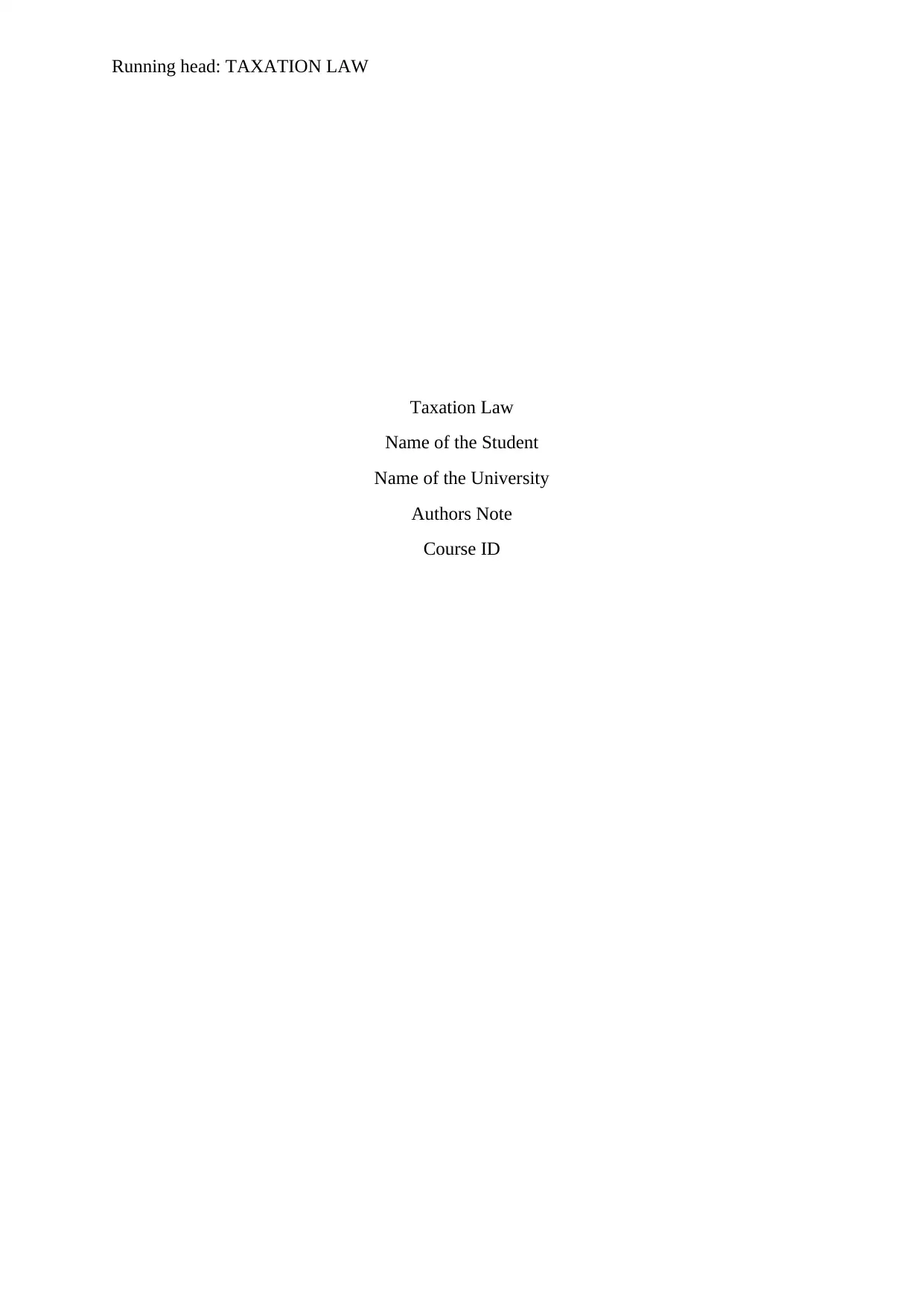
Running head: TAXATION LAW
Taxation Law
Name of the Student
Name of the University
Authors Note
Course ID
Taxation Law
Name of the Student
Name of the University
Authors Note
Course ID
Secure Best Marks with AI Grader
Need help grading? Try our AI Grader for instant feedback on your assignments.
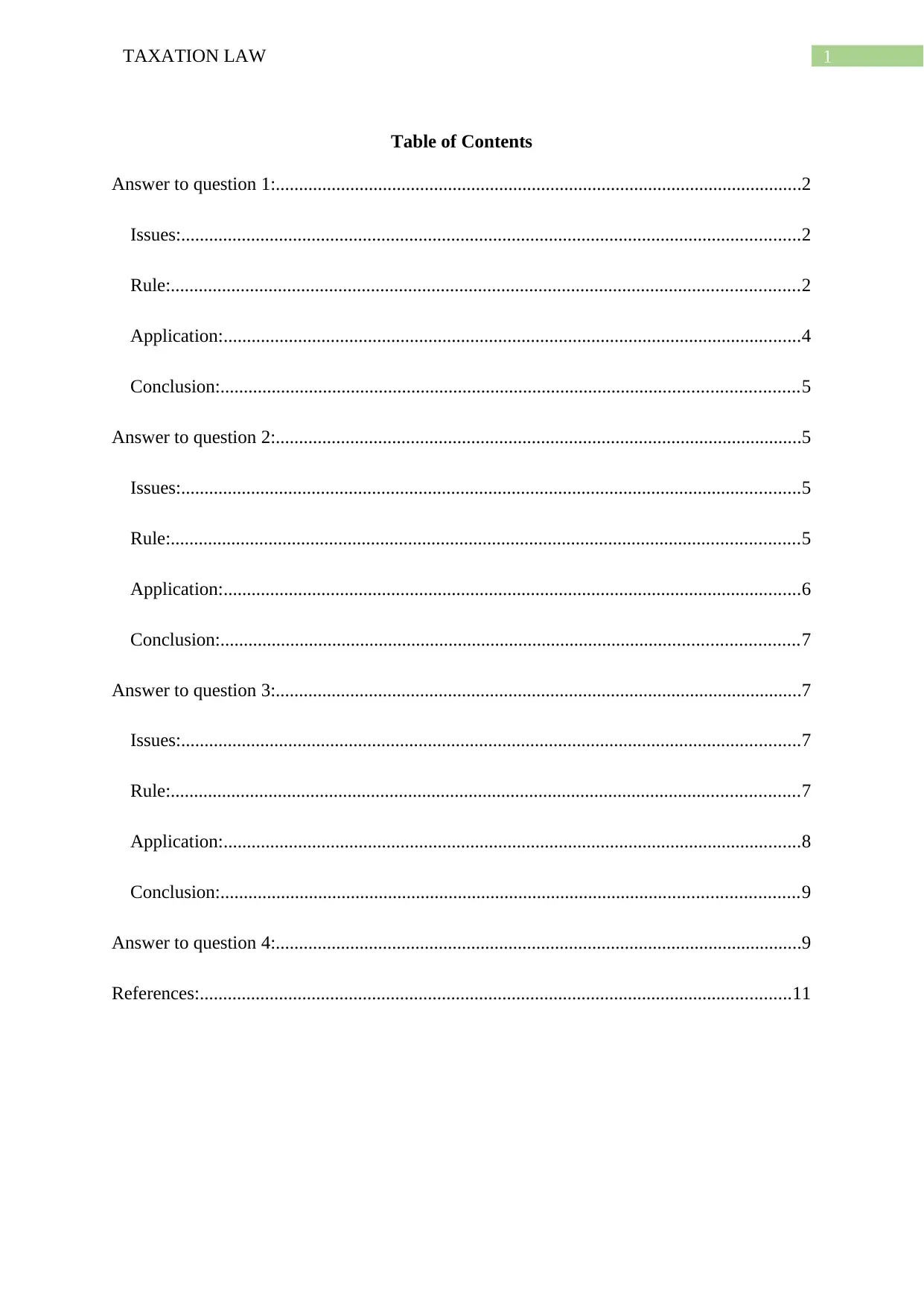
1TAXATION LAW
Table of Contents
Answer to question 1:.................................................................................................................2
Issues:.....................................................................................................................................2
Rule:.......................................................................................................................................2
Application:............................................................................................................................4
Conclusion:............................................................................................................................5
Answer to question 2:.................................................................................................................5
Issues:.....................................................................................................................................5
Rule:.......................................................................................................................................5
Application:............................................................................................................................6
Conclusion:............................................................................................................................7
Answer to question 3:.................................................................................................................7
Issues:.....................................................................................................................................7
Rule:.......................................................................................................................................7
Application:............................................................................................................................8
Conclusion:............................................................................................................................9
Answer to question 4:.................................................................................................................9
References:...............................................................................................................................11
Table of Contents
Answer to question 1:.................................................................................................................2
Issues:.....................................................................................................................................2
Rule:.......................................................................................................................................2
Application:............................................................................................................................4
Conclusion:............................................................................................................................5
Answer to question 2:.................................................................................................................5
Issues:.....................................................................................................................................5
Rule:.......................................................................................................................................5
Application:............................................................................................................................6
Conclusion:............................................................................................................................7
Answer to question 3:.................................................................................................................7
Issues:.....................................................................................................................................7
Rule:.......................................................................................................................................7
Application:............................................................................................................................8
Conclusion:............................................................................................................................9
Answer to question 4:.................................................................................................................9
References:...............................................................................................................................11
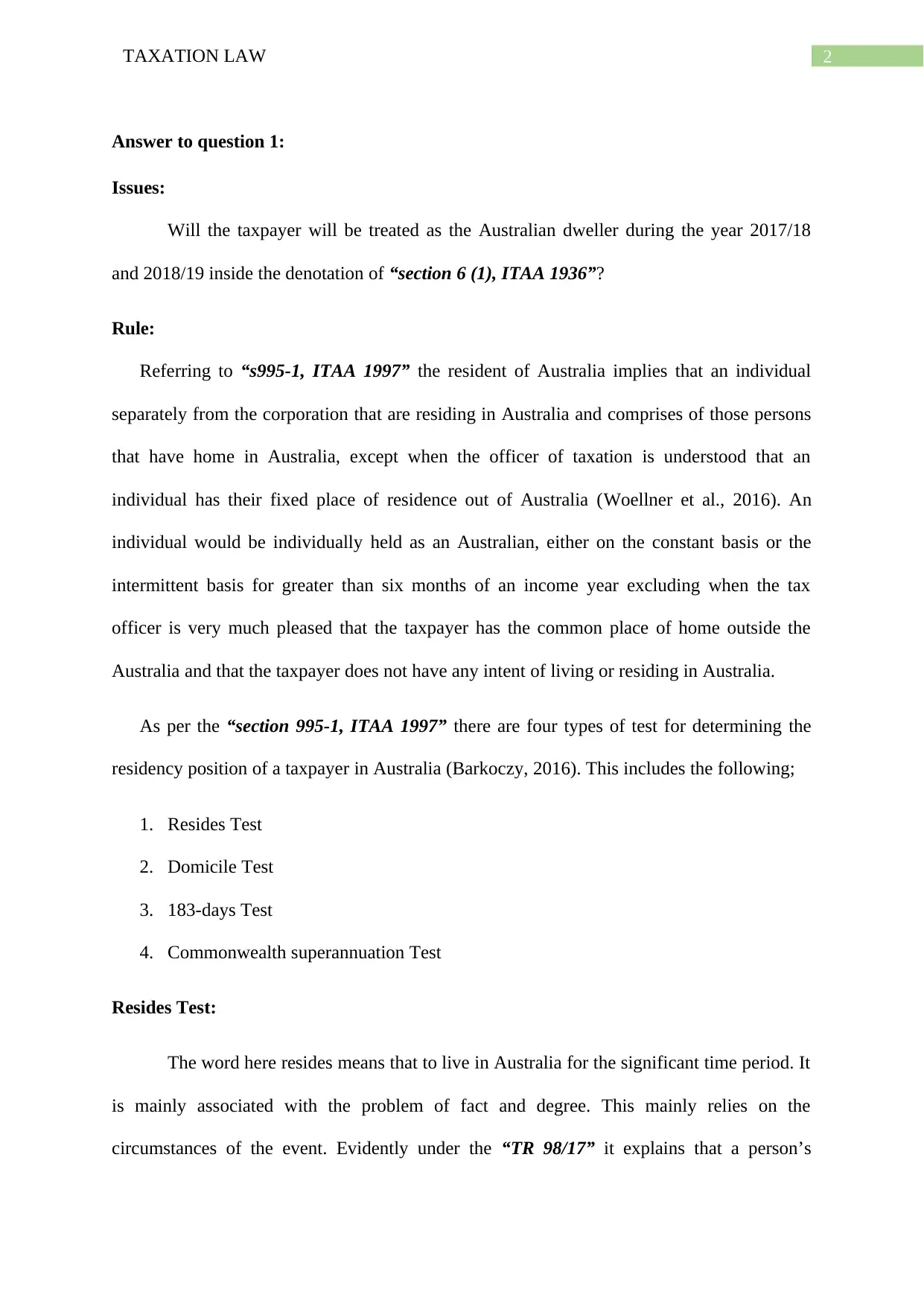
2TAXATION LAW
Answer to question 1:
Issues:
Will the taxpayer will be treated as the Australian dweller during the year 2017/18
and 2018/19 inside the denotation of “section 6 (1), ITAA 1936”?
Rule:
Referring to “s995-1, ITAA 1997” the resident of Australia implies that an individual
separately from the corporation that are residing in Australia and comprises of those persons
that have home in Australia, except when the officer of taxation is understood that an
individual has their fixed place of residence out of Australia (Woellner et al., 2016). An
individual would be individually held as an Australian, either on the constant basis or the
intermittent basis for greater than six months of an income year excluding when the tax
officer is very much pleased that the taxpayer has the common place of home outside the
Australia and that the taxpayer does not have any intent of living or residing in Australia.
As per the “section 995-1, ITAA 1997” there are four types of test for determining the
residency position of a taxpayer in Australia (Barkoczy, 2016). This includes the following;
1. Resides Test
2. Domicile Test
3. 183-days Test
4. Commonwealth superannuation Test
Resides Test:
The word here resides means that to live in Australia for the significant time period. It
is mainly associated with the problem of fact and degree. This mainly relies on the
circumstances of the event. Evidently under the “TR 98/17” it explains that a person’s
Answer to question 1:
Issues:
Will the taxpayer will be treated as the Australian dweller during the year 2017/18
and 2018/19 inside the denotation of “section 6 (1), ITAA 1936”?
Rule:
Referring to “s995-1, ITAA 1997” the resident of Australia implies that an individual
separately from the corporation that are residing in Australia and comprises of those persons
that have home in Australia, except when the officer of taxation is understood that an
individual has their fixed place of residence out of Australia (Woellner et al., 2016). An
individual would be individually held as an Australian, either on the constant basis or the
intermittent basis for greater than six months of an income year excluding when the tax
officer is very much pleased that the taxpayer has the common place of home outside the
Australia and that the taxpayer does not have any intent of living or residing in Australia.
As per the “section 995-1, ITAA 1997” there are four types of test for determining the
residency position of a taxpayer in Australia (Barkoczy, 2016). This includes the following;
1. Resides Test
2. Domicile Test
3. 183-days Test
4. Commonwealth superannuation Test
Resides Test:
The word here resides means that to live in Australia for the significant time period. It
is mainly associated with the problem of fact and degree. This mainly relies on the
circumstances of the event. Evidently under the “TR 98/17” it explains that a person’s
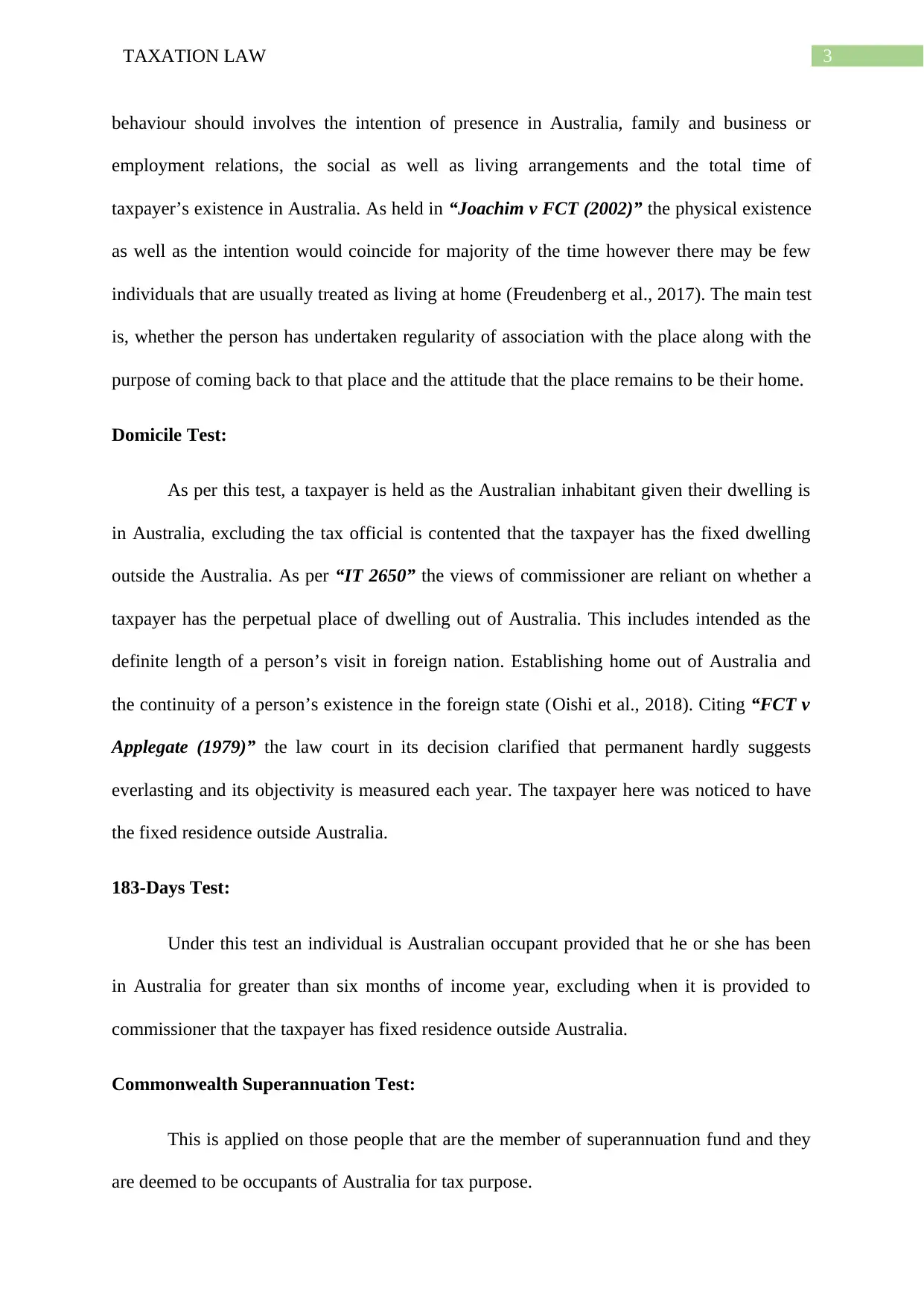
3TAXATION LAW
behaviour should involves the intention of presence in Australia, family and business or
employment relations, the social as well as living arrangements and the total time of
taxpayer’s existence in Australia. As held in “Joachim v FCT (2002)” the physical existence
as well as the intention would coincide for majority of the time however there may be few
individuals that are usually treated as living at home (Freudenberg et al., 2017). The main test
is, whether the person has undertaken regularity of association with the place along with the
purpose of coming back to that place and the attitude that the place remains to be their home.
Domicile Test:
As per this test, a taxpayer is held as the Australian inhabitant given their dwelling is
in Australia, excluding the tax official is contented that the taxpayer has the fixed dwelling
outside the Australia. As per “IT 2650” the views of commissioner are reliant on whether a
taxpayer has the perpetual place of dwelling out of Australia. This includes intended as the
definite length of a person’s visit in foreign nation. Establishing home out of Australia and
the continuity of a person’s existence in the foreign state (Oishi et al., 2018). Citing “FCT v
Applegate (1979)” the law court in its decision clarified that permanent hardly suggests
everlasting and its objectivity is measured each year. The taxpayer here was noticed to have
the fixed residence outside Australia.
183-Days Test:
Under this test an individual is Australian occupant provided that he or she has been
in Australia for greater than six months of income year, excluding when it is provided to
commissioner that the taxpayer has fixed residence outside Australia.
Commonwealth Superannuation Test:
This is applied on those people that are the member of superannuation fund and they
are deemed to be occupants of Australia for tax purpose.
behaviour should involves the intention of presence in Australia, family and business or
employment relations, the social as well as living arrangements and the total time of
taxpayer’s existence in Australia. As held in “Joachim v FCT (2002)” the physical existence
as well as the intention would coincide for majority of the time however there may be few
individuals that are usually treated as living at home (Freudenberg et al., 2017). The main test
is, whether the person has undertaken regularity of association with the place along with the
purpose of coming back to that place and the attitude that the place remains to be their home.
Domicile Test:
As per this test, a taxpayer is held as the Australian inhabitant given their dwelling is
in Australia, excluding the tax official is contented that the taxpayer has the fixed dwelling
outside the Australia. As per “IT 2650” the views of commissioner are reliant on whether a
taxpayer has the perpetual place of dwelling out of Australia. This includes intended as the
definite length of a person’s visit in foreign nation. Establishing home out of Australia and
the continuity of a person’s existence in the foreign state (Oishi et al., 2018). Citing “FCT v
Applegate (1979)” the law court in its decision clarified that permanent hardly suggests
everlasting and its objectivity is measured each year. The taxpayer here was noticed to have
the fixed residence outside Australia.
183-Days Test:
Under this test an individual is Australian occupant provided that he or she has been
in Australia for greater than six months of income year, excluding when it is provided to
commissioner that the taxpayer has fixed residence outside Australia.
Commonwealth Superannuation Test:
This is applied on those people that are the member of superannuation fund and they
are deemed to be occupants of Australia for tax purpose.
Secure Best Marks with AI Grader
Need help grading? Try our AI Grader for instant feedback on your assignments.
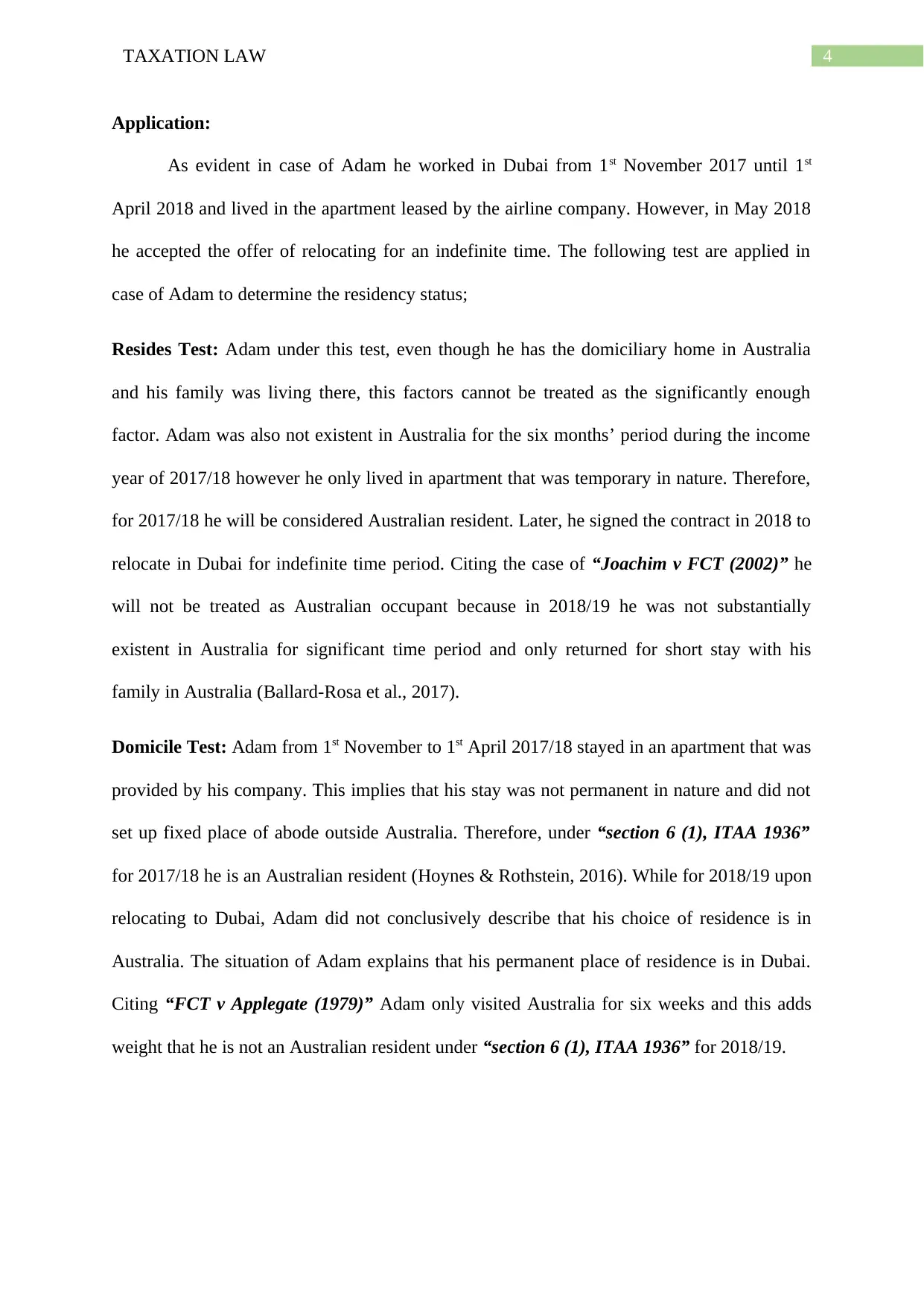
4TAXATION LAW
Application:
As evident in case of Adam he worked in Dubai from 1st November 2017 until 1st
April 2018 and lived in the apartment leased by the airline company. However, in May 2018
he accepted the offer of relocating for an indefinite time. The following test are applied in
case of Adam to determine the residency status;
Resides Test: Adam under this test, even though he has the domiciliary home in Australia
and his family was living there, this factors cannot be treated as the significantly enough
factor. Adam was also not existent in Australia for the six months’ period during the income
year of 2017/18 however he only lived in apartment that was temporary in nature. Therefore,
for 2017/18 he will be considered Australian resident. Later, he signed the contract in 2018 to
relocate in Dubai for indefinite time period. Citing the case of “Joachim v FCT (2002)” he
will not be treated as Australian occupant because in 2018/19 he was not substantially
existent in Australia for significant time period and only returned for short stay with his
family in Australia (Ballard-Rosa et al., 2017).
Domicile Test: Adam from 1st November to 1st April 2017/18 stayed in an apartment that was
provided by his company. This implies that his stay was not permanent in nature and did not
set up fixed place of abode outside Australia. Therefore, under “section 6 (1), ITAA 1936”
for 2017/18 he is an Australian resident (Hoynes & Rothstein, 2016). While for 2018/19 upon
relocating to Dubai, Adam did not conclusively describe that his choice of residence is in
Australia. The situation of Adam explains that his permanent place of residence is in Dubai.
Citing “FCT v Applegate (1979)” Adam only visited Australia for six weeks and this adds
weight that he is not an Australian resident under “section 6 (1), ITAA 1936” for 2018/19.
Application:
As evident in case of Adam he worked in Dubai from 1st November 2017 until 1st
April 2018 and lived in the apartment leased by the airline company. However, in May 2018
he accepted the offer of relocating for an indefinite time. The following test are applied in
case of Adam to determine the residency status;
Resides Test: Adam under this test, even though he has the domiciliary home in Australia
and his family was living there, this factors cannot be treated as the significantly enough
factor. Adam was also not existent in Australia for the six months’ period during the income
year of 2017/18 however he only lived in apartment that was temporary in nature. Therefore,
for 2017/18 he will be considered Australian resident. Later, he signed the contract in 2018 to
relocate in Dubai for indefinite time period. Citing the case of “Joachim v FCT (2002)” he
will not be treated as Australian occupant because in 2018/19 he was not substantially
existent in Australia for significant time period and only returned for short stay with his
family in Australia (Ballard-Rosa et al., 2017).
Domicile Test: Adam from 1st November to 1st April 2017/18 stayed in an apartment that was
provided by his company. This implies that his stay was not permanent in nature and did not
set up fixed place of abode outside Australia. Therefore, under “section 6 (1), ITAA 1936”
for 2017/18 he is an Australian resident (Hoynes & Rothstein, 2016). While for 2018/19 upon
relocating to Dubai, Adam did not conclusively describe that his choice of residence is in
Australia. The situation of Adam explains that his permanent place of residence is in Dubai.
Citing “FCT v Applegate (1979)” Adam only visited Australia for six weeks and this adds
weight that he is not an Australian resident under “section 6 (1), ITAA 1936” for 2018/19.
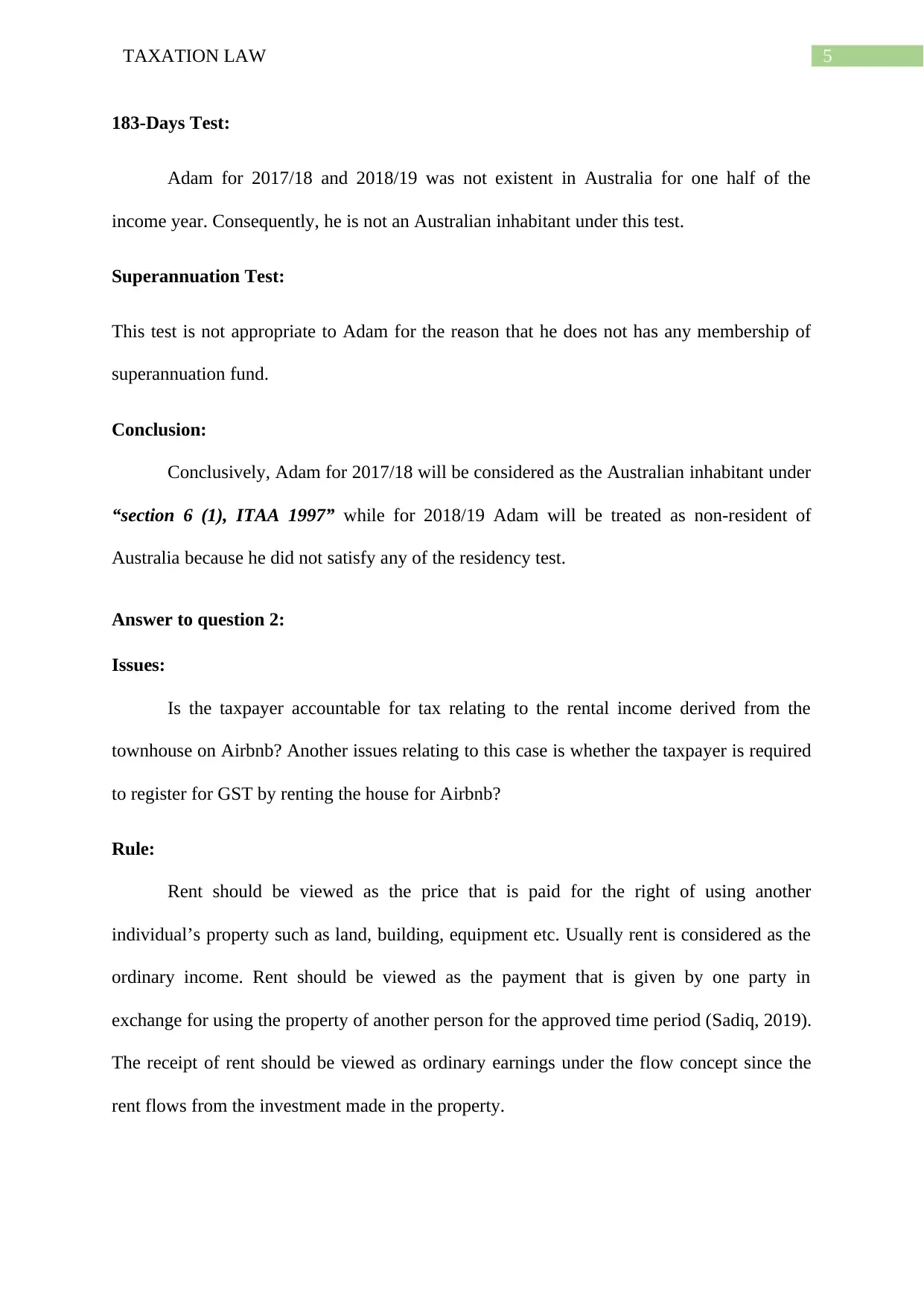
5TAXATION LAW
183-Days Test:
Adam for 2017/18 and 2018/19 was not existent in Australia for one half of the
income year. Consequently, he is not an Australian inhabitant under this test.
Superannuation Test:
This test is not appropriate to Adam for the reason that he does not has any membership of
superannuation fund.
Conclusion:
Conclusively, Adam for 2017/18 will be considered as the Australian inhabitant under
“section 6 (1), ITAA 1997” while for 2018/19 Adam will be treated as non-resident of
Australia because he did not satisfy any of the residency test.
Answer to question 2:
Issues:
Is the taxpayer accountable for tax relating to the rental income derived from the
townhouse on Airbnb? Another issues relating to this case is whether the taxpayer is required
to register for GST by renting the house for Airbnb?
Rule:
Rent should be viewed as the price that is paid for the right of using another
individual’s property such as land, building, equipment etc. Usually rent is considered as the
ordinary income. Rent should be viewed as the payment that is given by one party in
exchange for using the property of another person for the approved time period (Sadiq, 2019).
The receipt of rent should be viewed as ordinary earnings under the flow concept since the
rent flows from the investment made in the property.
183-Days Test:
Adam for 2017/18 and 2018/19 was not existent in Australia for one half of the
income year. Consequently, he is not an Australian inhabitant under this test.
Superannuation Test:
This test is not appropriate to Adam for the reason that he does not has any membership of
superannuation fund.
Conclusion:
Conclusively, Adam for 2017/18 will be considered as the Australian inhabitant under
“section 6 (1), ITAA 1997” while for 2018/19 Adam will be treated as non-resident of
Australia because he did not satisfy any of the residency test.
Answer to question 2:
Issues:
Is the taxpayer accountable for tax relating to the rental income derived from the
townhouse on Airbnb? Another issues relating to this case is whether the taxpayer is required
to register for GST by renting the house for Airbnb?
Rule:
Rent should be viewed as the price that is paid for the right of using another
individual’s property such as land, building, equipment etc. Usually rent is considered as the
ordinary income. Rent should be viewed as the payment that is given by one party in
exchange for using the property of another person for the approved time period (Sadiq, 2019).
The receipt of rent should be viewed as ordinary earnings under the flow concept since the
rent flows from the investment made in the property.
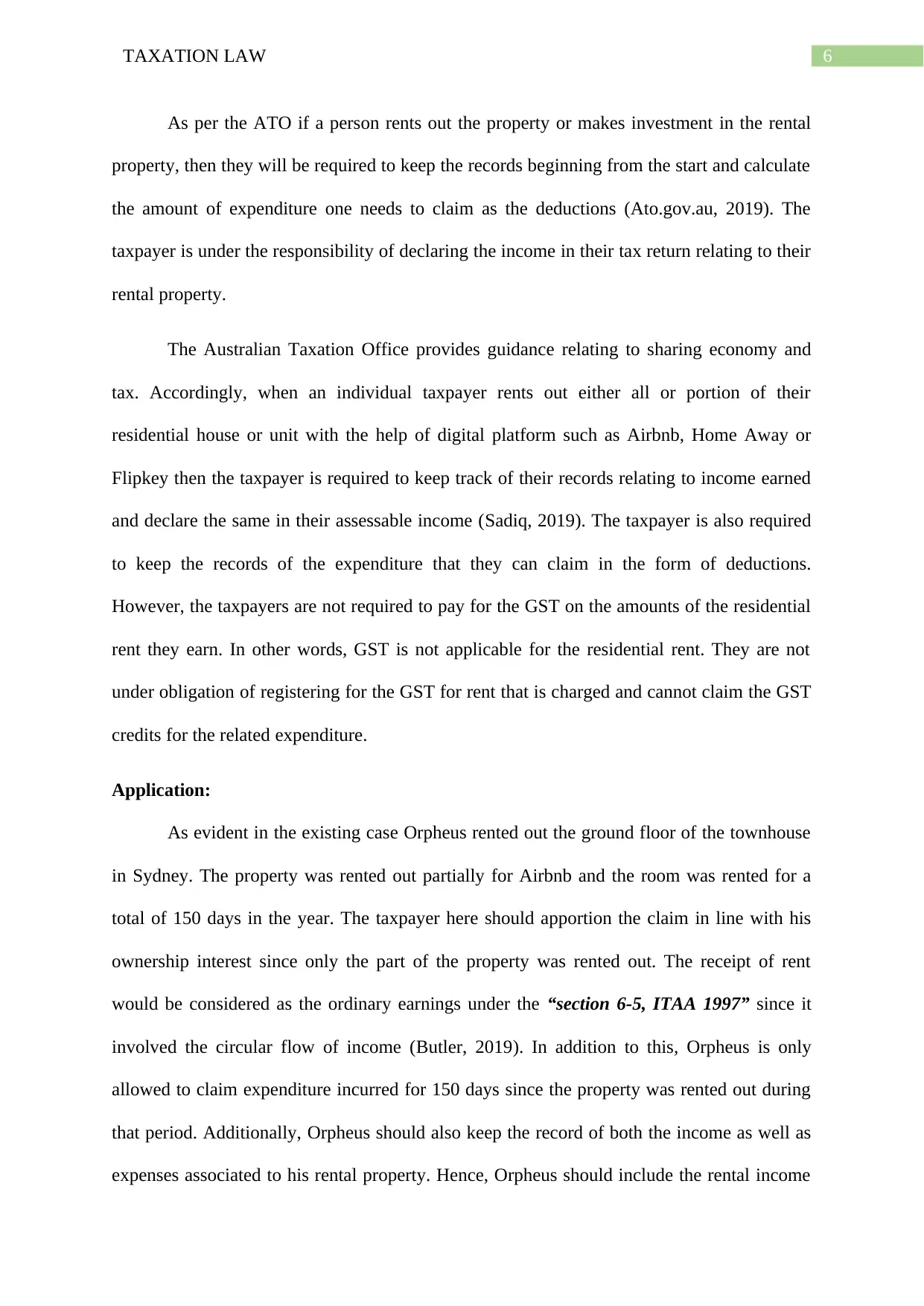
6TAXATION LAW
As per the ATO if a person rents out the property or makes investment in the rental
property, then they will be required to keep the records beginning from the start and calculate
the amount of expenditure one needs to claim as the deductions (Ato.gov.au, 2019). The
taxpayer is under the responsibility of declaring the income in their tax return relating to their
rental property.
The Australian Taxation Office provides guidance relating to sharing economy and
tax. Accordingly, when an individual taxpayer rents out either all or portion of their
residential house or unit with the help of digital platform such as Airbnb, Home Away or
Flipkey then the taxpayer is required to keep track of their records relating to income earned
and declare the same in their assessable income (Sadiq, 2019). The taxpayer is also required
to keep the records of the expenditure that they can claim in the form of deductions.
However, the taxpayers are not required to pay for the GST on the amounts of the residential
rent they earn. In other words, GST is not applicable for the residential rent. They are not
under obligation of registering for the GST for rent that is charged and cannot claim the GST
credits for the related expenditure.
Application:
As evident in the existing case Orpheus rented out the ground floor of the townhouse
in Sydney. The property was rented out partially for Airbnb and the room was rented for a
total of 150 days in the year. The taxpayer here should apportion the claim in line with his
ownership interest since only the part of the property was rented out. The receipt of rent
would be considered as the ordinary earnings under the “section 6-5, ITAA 1997” since it
involved the circular flow of income (Butler, 2019). In addition to this, Orpheus is only
allowed to claim expenditure incurred for 150 days since the property was rented out during
that period. Additionally, Orpheus should also keep the record of both the income as well as
expenses associated to his rental property. Hence, Orpheus should include the rental income
As per the ATO if a person rents out the property or makes investment in the rental
property, then they will be required to keep the records beginning from the start and calculate
the amount of expenditure one needs to claim as the deductions (Ato.gov.au, 2019). The
taxpayer is under the responsibility of declaring the income in their tax return relating to their
rental property.
The Australian Taxation Office provides guidance relating to sharing economy and
tax. Accordingly, when an individual taxpayer rents out either all or portion of their
residential house or unit with the help of digital platform such as Airbnb, Home Away or
Flipkey then the taxpayer is required to keep track of their records relating to income earned
and declare the same in their assessable income (Sadiq, 2019). The taxpayer is also required
to keep the records of the expenditure that they can claim in the form of deductions.
However, the taxpayers are not required to pay for the GST on the amounts of the residential
rent they earn. In other words, GST is not applicable for the residential rent. They are not
under obligation of registering for the GST for rent that is charged and cannot claim the GST
credits for the related expenditure.
Application:
As evident in the existing case Orpheus rented out the ground floor of the townhouse
in Sydney. The property was rented out partially for Airbnb and the room was rented for a
total of 150 days in the year. The taxpayer here should apportion the claim in line with his
ownership interest since only the part of the property was rented out. The receipt of rent
would be considered as the ordinary earnings under the “section 6-5, ITAA 1997” since it
involved the circular flow of income (Butler, 2019). In addition to this, Orpheus is only
allowed to claim expenditure incurred for 150 days since the property was rented out during
that period. Additionally, Orpheus should also keep the record of both the income as well as
expenses associated to his rental property. Hence, Orpheus should include the rental income
Paraphrase This Document
Need a fresh take? Get an instant paraphrase of this document with our AI Paraphraser
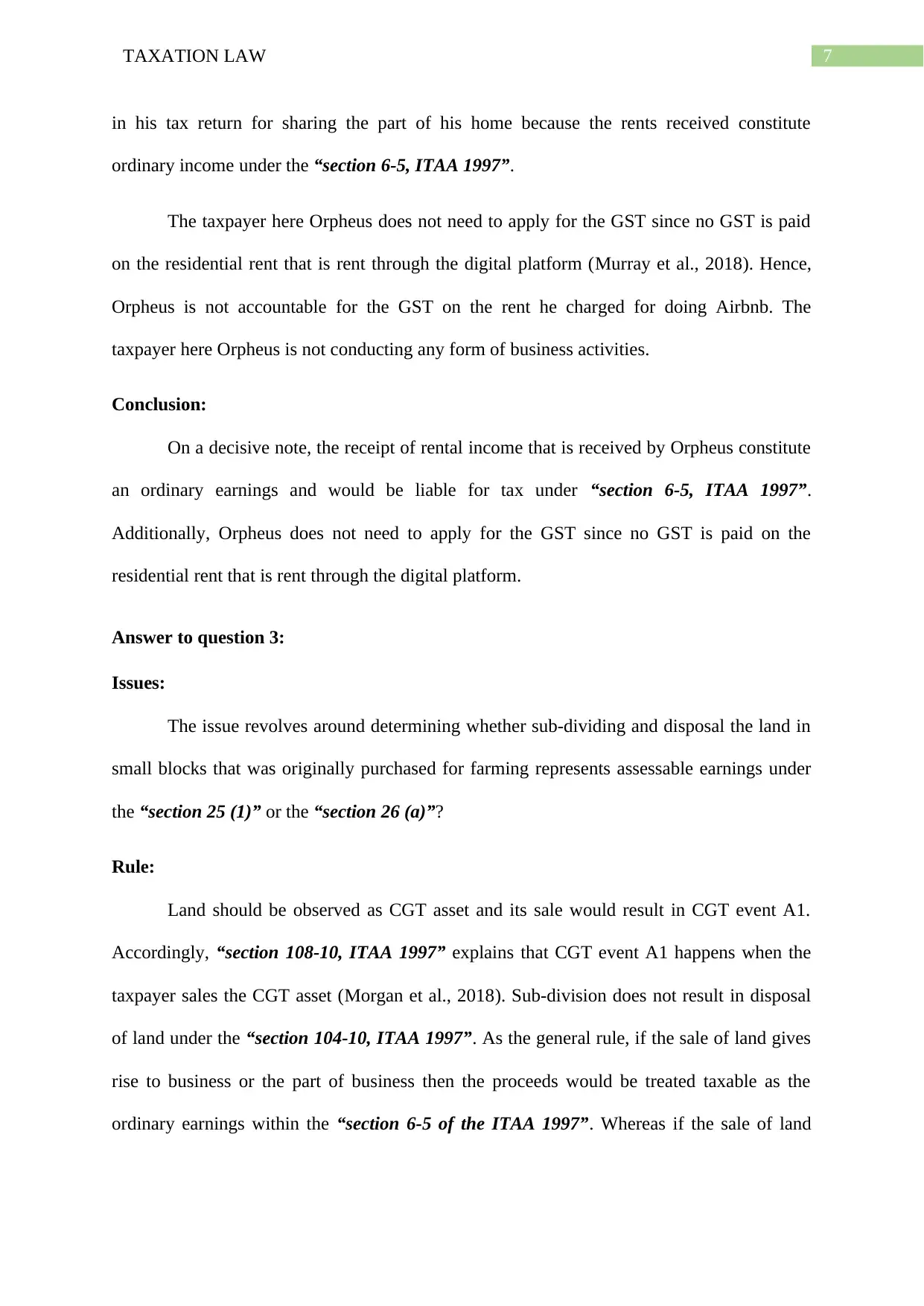
7TAXATION LAW
in his tax return for sharing the part of his home because the rents received constitute
ordinary income under the “section 6-5, ITAA 1997”.
The taxpayer here Orpheus does not need to apply for the GST since no GST is paid
on the residential rent that is rent through the digital platform (Murray et al., 2018). Hence,
Orpheus is not accountable for the GST on the rent he charged for doing Airbnb. The
taxpayer here Orpheus is not conducting any form of business activities.
Conclusion:
On a decisive note, the receipt of rental income that is received by Orpheus constitute
an ordinary earnings and would be liable for tax under “section 6-5, ITAA 1997”.
Additionally, Orpheus does not need to apply for the GST since no GST is paid on the
residential rent that is rent through the digital platform.
Answer to question 3:
Issues:
The issue revolves around determining whether sub-dividing and disposal the land in
small blocks that was originally purchased for farming represents assessable earnings under
the “section 25 (1)” or the “section 26 (a)”?
Rule:
Land should be observed as CGT asset and its sale would result in CGT event A1.
Accordingly, “section 108-10, ITAA 1997” explains that CGT event A1 happens when the
taxpayer sales the CGT asset (Morgan et al., 2018). Sub-division does not result in disposal
of land under the “section 104-10, ITAA 1997”. As the general rule, if the sale of land gives
rise to business or the part of business then the proceeds would be treated taxable as the
ordinary earnings within the “section 6-5 of the ITAA 1997”. Whereas if the sale of land
in his tax return for sharing the part of his home because the rents received constitute
ordinary income under the “section 6-5, ITAA 1997”.
The taxpayer here Orpheus does not need to apply for the GST since no GST is paid
on the residential rent that is rent through the digital platform (Murray et al., 2018). Hence,
Orpheus is not accountable for the GST on the rent he charged for doing Airbnb. The
taxpayer here Orpheus is not conducting any form of business activities.
Conclusion:
On a decisive note, the receipt of rental income that is received by Orpheus constitute
an ordinary earnings and would be liable for tax under “section 6-5, ITAA 1997”.
Additionally, Orpheus does not need to apply for the GST since no GST is paid on the
residential rent that is rent through the digital platform.
Answer to question 3:
Issues:
The issue revolves around determining whether sub-dividing and disposal the land in
small blocks that was originally purchased for farming represents assessable earnings under
the “section 25 (1)” or the “section 26 (a)”?
Rule:
Land should be observed as CGT asset and its sale would result in CGT event A1.
Accordingly, “section 108-10, ITAA 1997” explains that CGT event A1 happens when the
taxpayer sales the CGT asset (Morgan et al., 2018). Sub-division does not result in disposal
of land under the “section 104-10, ITAA 1997”. As the general rule, if the sale of land gives
rise to business or the part of business then the proceeds would be treated taxable as the
ordinary earnings within the “section 6-5 of the ITAA 1997”. Whereas if the sale of land
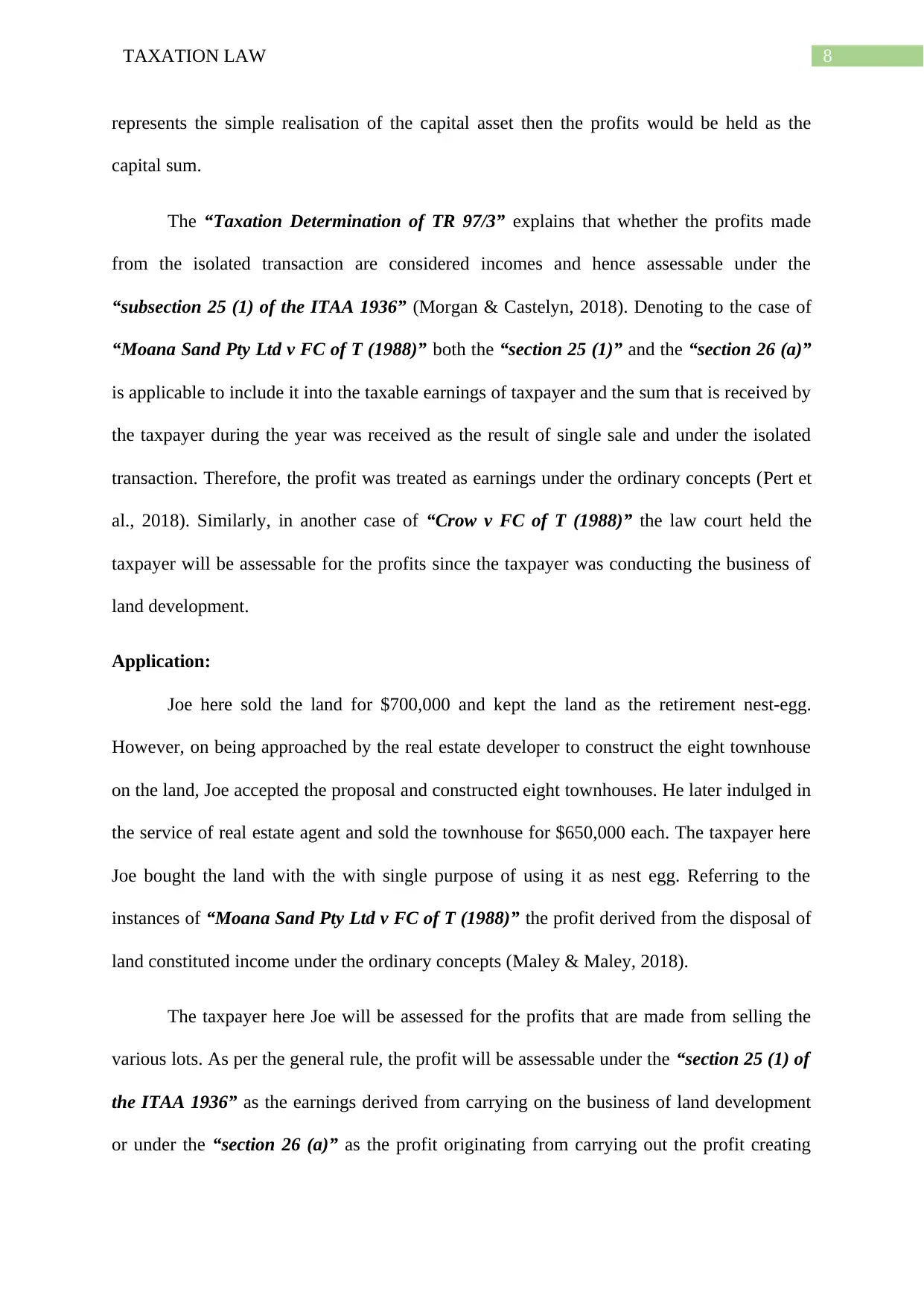
8TAXATION LAW
represents the simple realisation of the capital asset then the profits would be held as the
capital sum.
The “Taxation Determination of TR 97/3” explains that whether the profits made
from the isolated transaction are considered incomes and hence assessable under the
“subsection 25 (1) of the ITAA 1936” (Morgan & Castelyn, 2018). Denoting to the case of
“Moana Sand Pty Ltd v FC of T (1988)” both the “section 25 (1)” and the “section 26 (a)”
is applicable to include it into the taxable earnings of taxpayer and the sum that is received by
the taxpayer during the year was received as the result of single sale and under the isolated
transaction. Therefore, the profit was treated as earnings under the ordinary concepts (Pert et
al., 2018). Similarly, in another case of “Crow v FC of T (1988)” the law court held the
taxpayer will be assessable for the profits since the taxpayer was conducting the business of
land development.
Application:
Joe here sold the land for $700,000 and kept the land as the retirement nest-egg.
However, on being approached by the real estate developer to construct the eight townhouse
on the land, Joe accepted the proposal and constructed eight townhouses. He later indulged in
the service of real estate agent and sold the townhouse for $650,000 each. The taxpayer here
Joe bought the land with the with single purpose of using it as nest egg. Referring to the
instances of “Moana Sand Pty Ltd v FC of T (1988)” the profit derived from the disposal of
land constituted income under the ordinary concepts (Maley & Maley, 2018).
The taxpayer here Joe will be assessed for the profits that are made from selling the
various lots. As per the general rule, the profit will be assessable under the “section 25 (1) of
the ITAA 1936” as the earnings derived from carrying on the business of land development
or under the “section 26 (a)” as the profit originating from carrying out the profit creating
represents the simple realisation of the capital asset then the profits would be held as the
capital sum.
The “Taxation Determination of TR 97/3” explains that whether the profits made
from the isolated transaction are considered incomes and hence assessable under the
“subsection 25 (1) of the ITAA 1936” (Morgan & Castelyn, 2018). Denoting to the case of
“Moana Sand Pty Ltd v FC of T (1988)” both the “section 25 (1)” and the “section 26 (a)”
is applicable to include it into the taxable earnings of taxpayer and the sum that is received by
the taxpayer during the year was received as the result of single sale and under the isolated
transaction. Therefore, the profit was treated as earnings under the ordinary concepts (Pert et
al., 2018). Similarly, in another case of “Crow v FC of T (1988)” the law court held the
taxpayer will be assessable for the profits since the taxpayer was conducting the business of
land development.
Application:
Joe here sold the land for $700,000 and kept the land as the retirement nest-egg.
However, on being approached by the real estate developer to construct the eight townhouse
on the land, Joe accepted the proposal and constructed eight townhouses. He later indulged in
the service of real estate agent and sold the townhouse for $650,000 each. The taxpayer here
Joe bought the land with the with single purpose of using it as nest egg. Referring to the
instances of “Moana Sand Pty Ltd v FC of T (1988)” the profit derived from the disposal of
land constituted income under the ordinary concepts (Maley & Maley, 2018).
The taxpayer here Joe will be assessed for the profits that are made from selling the
various lots. As per the general rule, the profit will be assessable under the “section 25 (1) of
the ITAA 1936” as the earnings derived from carrying on the business of land development
or under the “section 26 (a)” as the profit originating from carrying out the profit creating
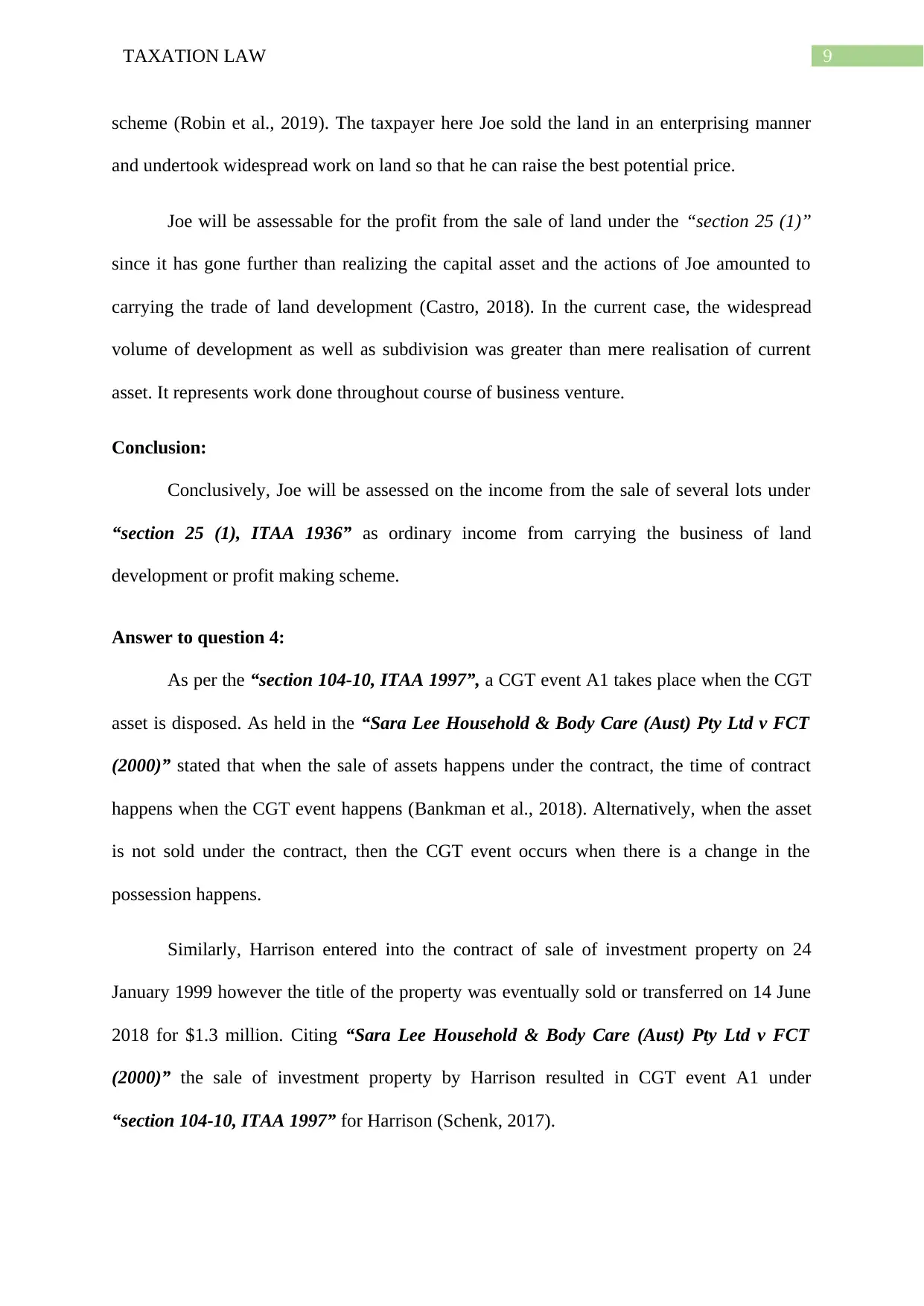
9TAXATION LAW
scheme (Robin et al., 2019). The taxpayer here Joe sold the land in an enterprising manner
and undertook widespread work on land so that he can raise the best potential price.
Joe will be assessable for the profit from the sale of land under the “section 25 (1)”
since it has gone further than realizing the capital asset and the actions of Joe amounted to
carrying the trade of land development (Castro, 2018). In the current case, the widespread
volume of development as well as subdivision was greater than mere realisation of current
asset. It represents work done throughout course of business venture.
Conclusion:
Conclusively, Joe will be assessed on the income from the sale of several lots under
“section 25 (1), ITAA 1936” as ordinary income from carrying the business of land
development or profit making scheme.
Answer to question 4:
As per the “section 104-10, ITAA 1997”, a CGT event A1 takes place when the CGT
asset is disposed. As held in the “Sara Lee Household & Body Care (Aust) Pty Ltd v FCT
(2000)” stated that when the sale of assets happens under the contract, the time of contract
happens when the CGT event happens (Bankman et al., 2018). Alternatively, when the asset
is not sold under the contract, then the CGT event occurs when there is a change in the
possession happens.
Similarly, Harrison entered into the contract of sale of investment property on 24
January 1999 however the title of the property was eventually sold or transferred on 14 June
2018 for $1.3 million. Citing “Sara Lee Household & Body Care (Aust) Pty Ltd v FCT
(2000)” the sale of investment property by Harrison resulted in CGT event A1 under
“section 104-10, ITAA 1997” for Harrison (Schenk, 2017).
scheme (Robin et al., 2019). The taxpayer here Joe sold the land in an enterprising manner
and undertook widespread work on land so that he can raise the best potential price.
Joe will be assessable for the profit from the sale of land under the “section 25 (1)”
since it has gone further than realizing the capital asset and the actions of Joe amounted to
carrying the trade of land development (Castro, 2018). In the current case, the widespread
volume of development as well as subdivision was greater than mere realisation of current
asset. It represents work done throughout course of business venture.
Conclusion:
Conclusively, Joe will be assessed on the income from the sale of several lots under
“section 25 (1), ITAA 1936” as ordinary income from carrying the business of land
development or profit making scheme.
Answer to question 4:
As per the “section 104-10, ITAA 1997”, a CGT event A1 takes place when the CGT
asset is disposed. As held in the “Sara Lee Household & Body Care (Aust) Pty Ltd v FCT
(2000)” stated that when the sale of assets happens under the contract, the time of contract
happens when the CGT event happens (Bankman et al., 2018). Alternatively, when the asset
is not sold under the contract, then the CGT event occurs when there is a change in the
possession happens.
Similarly, Harrison entered into the contract of sale of investment property on 24
January 1999 however the title of the property was eventually sold or transferred on 14 June
2018 for $1.3 million. Citing “Sara Lee Household & Body Care (Aust) Pty Ltd v FCT
(2000)” the sale of investment property by Harrison resulted in CGT event A1 under
“section 104-10, ITAA 1997” for Harrison (Schenk, 2017).
Secure Best Marks with AI Grader
Need help grading? Try our AI Grader for instant feedback on your assignments.
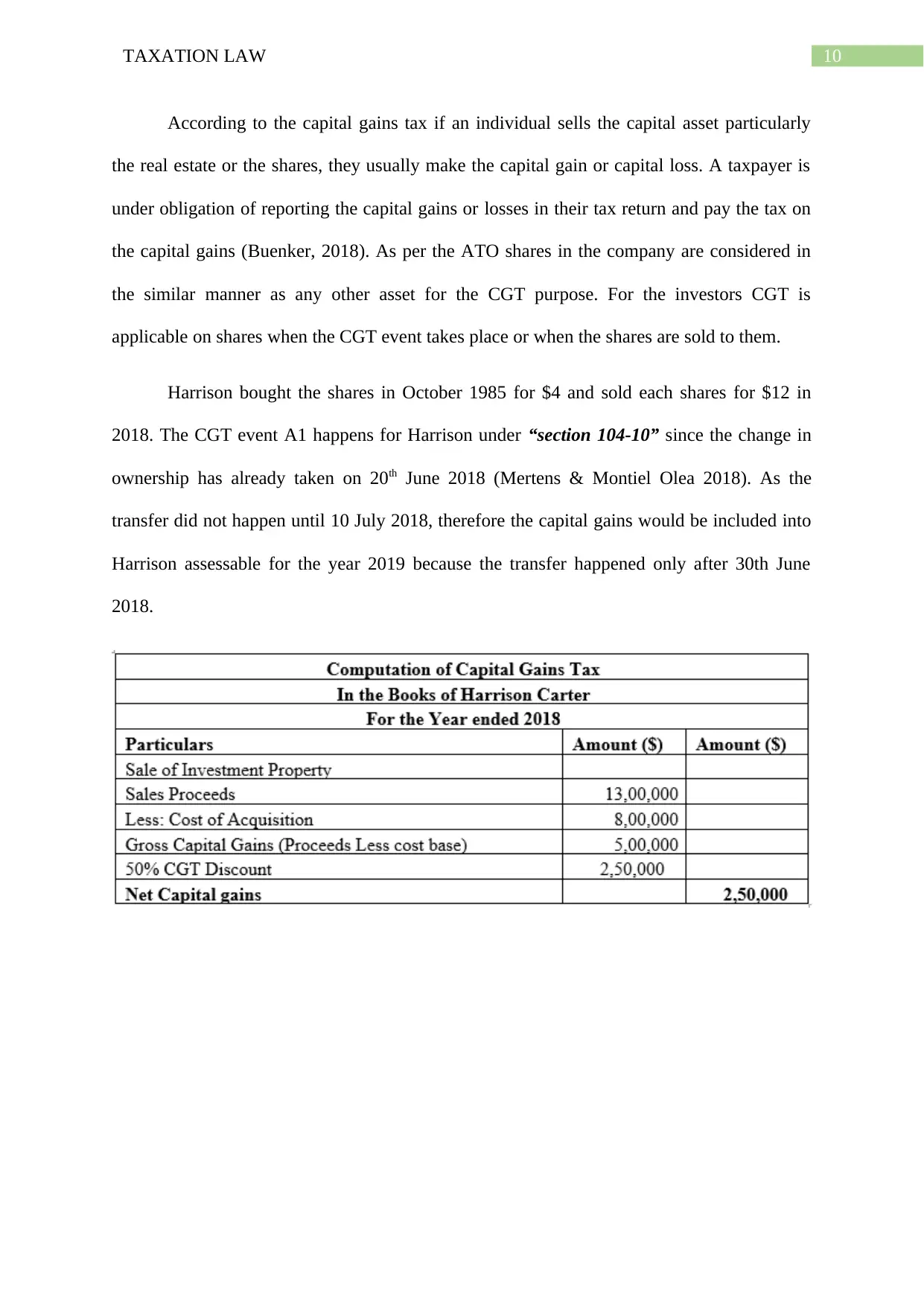
10TAXATION LAW
According to the capital gains tax if an individual sells the capital asset particularly
the real estate or the shares, they usually make the capital gain or capital loss. A taxpayer is
under obligation of reporting the capital gains or losses in their tax return and pay the tax on
the capital gains (Buenker, 2018). As per the ATO shares in the company are considered in
the similar manner as any other asset for the CGT purpose. For the investors CGT is
applicable on shares when the CGT event takes place or when the shares are sold to them.
Harrison bought the shares in October 1985 for $4 and sold each shares for $12 in
2018. The CGT event A1 happens for Harrison under “section 104-10” since the change in
ownership has already taken on 20th June 2018 (Mertens & Montiel Olea 2018). As the
transfer did not happen until 10 July 2018, therefore the capital gains would be included into
Harrison assessable for the year 2019 because the transfer happened only after 30th June
2018.
According to the capital gains tax if an individual sells the capital asset particularly
the real estate or the shares, they usually make the capital gain or capital loss. A taxpayer is
under obligation of reporting the capital gains or losses in their tax return and pay the tax on
the capital gains (Buenker, 2018). As per the ATO shares in the company are considered in
the similar manner as any other asset for the CGT purpose. For the investors CGT is
applicable on shares when the CGT event takes place or when the shares are sold to them.
Harrison bought the shares in October 1985 for $4 and sold each shares for $12 in
2018. The CGT event A1 happens for Harrison under “section 104-10” since the change in
ownership has already taken on 20th June 2018 (Mertens & Montiel Olea 2018). As the
transfer did not happen until 10 July 2018, therefore the capital gains would be included into
Harrison assessable for the year 2019 because the transfer happened only after 30th June
2018.
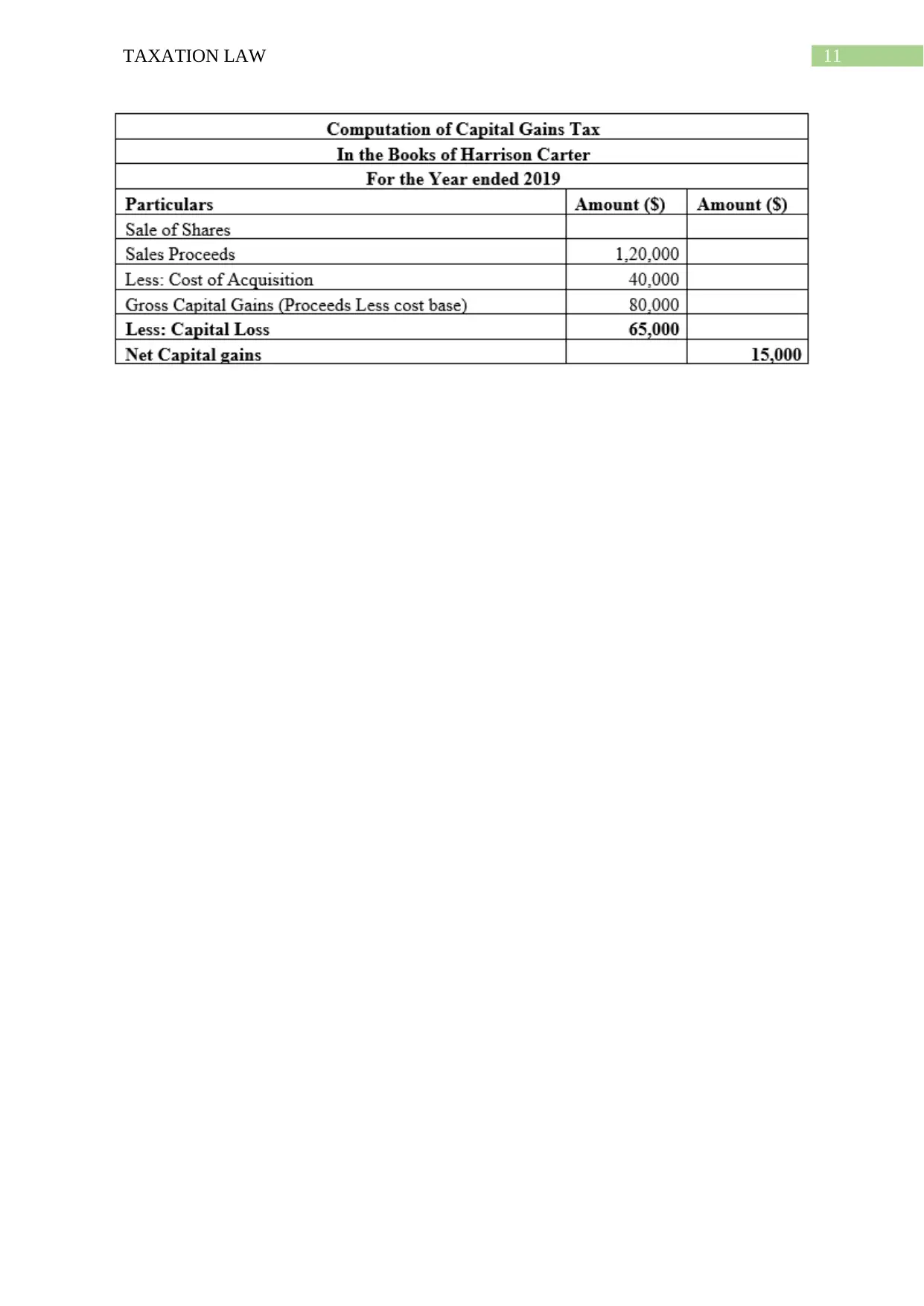
11TAXATION LAW
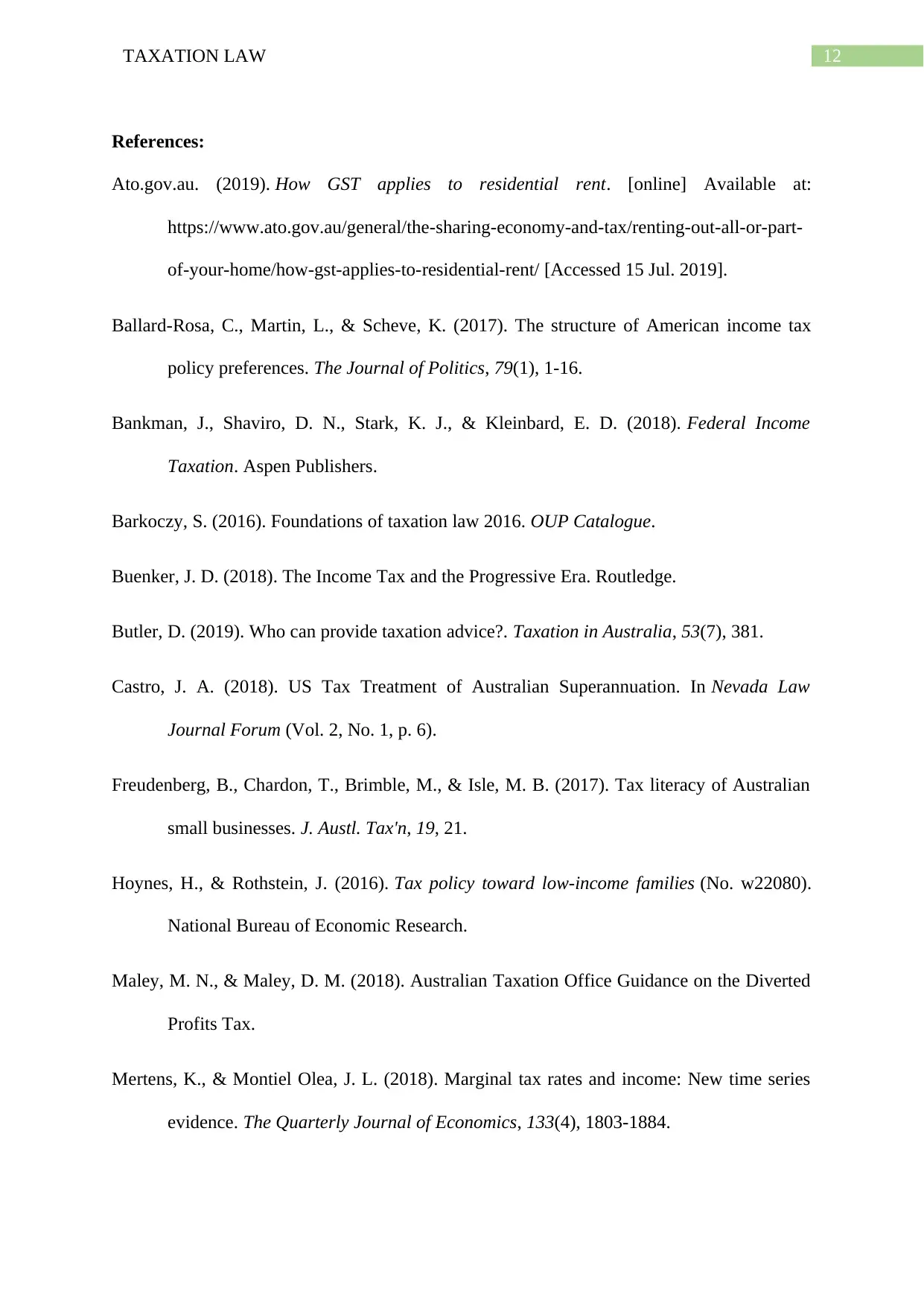
12TAXATION LAW
References:
Ato.gov.au. (2019). How GST applies to residential rent. [online] Available at:
https://www.ato.gov.au/general/the-sharing-economy-and-tax/renting-out-all-or-part-
of-your-home/how-gst-applies-to-residential-rent/ [Accessed 15 Jul. 2019].
Ballard-Rosa, C., Martin, L., & Scheve, K. (2017). The structure of American income tax
policy preferences. The Journal of Politics, 79(1), 1-16.
Bankman, J., Shaviro, D. N., Stark, K. J., & Kleinbard, E. D. (2018). Federal Income
Taxation. Aspen Publishers.
Barkoczy, S. (2016). Foundations of taxation law 2016. OUP Catalogue.
Buenker, J. D. (2018). The Income Tax and the Progressive Era. Routledge.
Butler, D. (2019). Who can provide taxation advice?. Taxation in Australia, 53(7), 381.
Castro, J. A. (2018). US Tax Treatment of Australian Superannuation. In Nevada Law
Journal Forum (Vol. 2, No. 1, p. 6).
Freudenberg, B., Chardon, T., Brimble, M., & Isle, M. B. (2017). Tax literacy of Australian
small businesses. J. Austl. Tax'n, 19, 21.
Hoynes, H., & Rothstein, J. (2016). Tax policy toward low-income families (No. w22080).
National Bureau of Economic Research.
Maley, M. N., & Maley, D. M. (2018). Australian Taxation Office Guidance on the Diverted
Profits Tax.
Mertens, K., & Montiel Olea, J. L. (2018). Marginal tax rates and income: New time series
evidence. The Quarterly Journal of Economics, 133(4), 1803-1884.
References:
Ato.gov.au. (2019). How GST applies to residential rent. [online] Available at:
https://www.ato.gov.au/general/the-sharing-economy-and-tax/renting-out-all-or-part-
of-your-home/how-gst-applies-to-residential-rent/ [Accessed 15 Jul. 2019].
Ballard-Rosa, C., Martin, L., & Scheve, K. (2017). The structure of American income tax
policy preferences. The Journal of Politics, 79(1), 1-16.
Bankman, J., Shaviro, D. N., Stark, K. J., & Kleinbard, E. D. (2018). Federal Income
Taxation. Aspen Publishers.
Barkoczy, S. (2016). Foundations of taxation law 2016. OUP Catalogue.
Buenker, J. D. (2018). The Income Tax and the Progressive Era. Routledge.
Butler, D. (2019). Who can provide taxation advice?. Taxation in Australia, 53(7), 381.
Castro, J. A. (2018). US Tax Treatment of Australian Superannuation. In Nevada Law
Journal Forum (Vol. 2, No. 1, p. 6).
Freudenberg, B., Chardon, T., Brimble, M., & Isle, M. B. (2017). Tax literacy of Australian
small businesses. J. Austl. Tax'n, 19, 21.
Hoynes, H., & Rothstein, J. (2016). Tax policy toward low-income families (No. w22080).
National Bureau of Economic Research.
Maley, M. N., & Maley, D. M. (2018). Australian Taxation Office Guidance on the Diverted
Profits Tax.
Mertens, K., & Montiel Olea, J. L. (2018). Marginal tax rates and income: New time series
evidence. The Quarterly Journal of Economics, 133(4), 1803-1884.
Paraphrase This Document
Need a fresh take? Get an instant paraphrase of this document with our AI Paraphraser
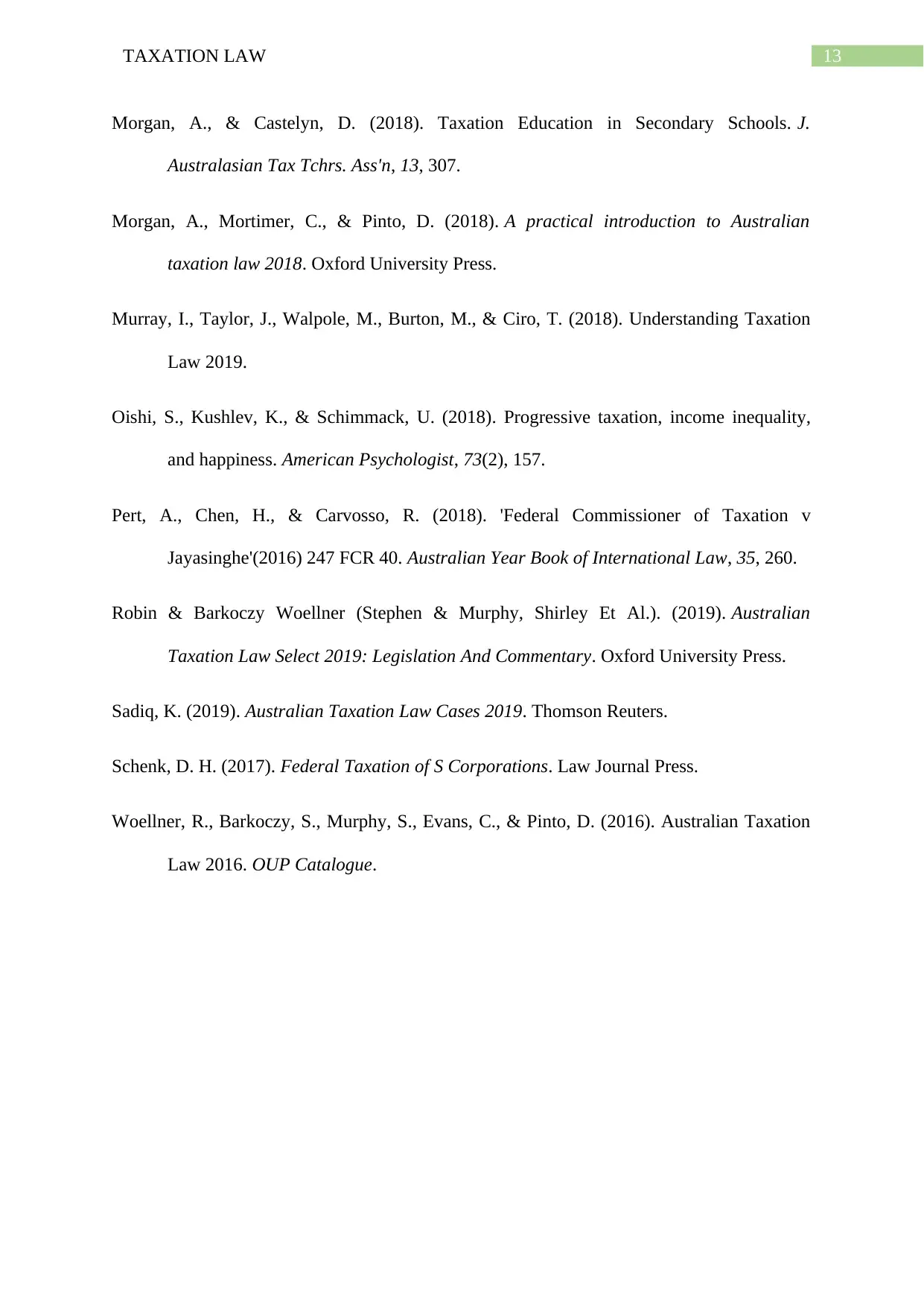
13TAXATION LAW
Morgan, A., & Castelyn, D. (2018). Taxation Education in Secondary Schools. J.
Australasian Tax Tchrs. Ass'n, 13, 307.
Morgan, A., Mortimer, C., & Pinto, D. (2018). A practical introduction to Australian
taxation law 2018. Oxford University Press.
Murray, I., Taylor, J., Walpole, M., Burton, M., & Ciro, T. (2018). Understanding Taxation
Law 2019.
Oishi, S., Kushlev, K., & Schimmack, U. (2018). Progressive taxation, income inequality,
and happiness. American Psychologist, 73(2), 157.
Pert, A., Chen, H., & Carvosso, R. (2018). 'Federal Commissioner of Taxation v
Jayasinghe'(2016) 247 FCR 40. Australian Year Book of International Law, 35, 260.
Robin & Barkoczy Woellner (Stephen & Murphy, Shirley Et Al.). (2019). Australian
Taxation Law Select 2019: Legislation And Commentary. Oxford University Press.
Sadiq, K. (2019). Australian Taxation Law Cases 2019. Thomson Reuters.
Schenk, D. H. (2017). Federal Taxation of S Corporations. Law Journal Press.
Woellner, R., Barkoczy, S., Murphy, S., Evans, C., & Pinto, D. (2016). Australian Taxation
Law 2016. OUP Catalogue.
Morgan, A., & Castelyn, D. (2018). Taxation Education in Secondary Schools. J.
Australasian Tax Tchrs. Ass'n, 13, 307.
Morgan, A., Mortimer, C., & Pinto, D. (2018). A practical introduction to Australian
taxation law 2018. Oxford University Press.
Murray, I., Taylor, J., Walpole, M., Burton, M., & Ciro, T. (2018). Understanding Taxation
Law 2019.
Oishi, S., Kushlev, K., & Schimmack, U. (2018). Progressive taxation, income inequality,
and happiness. American Psychologist, 73(2), 157.
Pert, A., Chen, H., & Carvosso, R. (2018). 'Federal Commissioner of Taxation v
Jayasinghe'(2016) 247 FCR 40. Australian Year Book of International Law, 35, 260.
Robin & Barkoczy Woellner (Stephen & Murphy, Shirley Et Al.). (2019). Australian
Taxation Law Select 2019: Legislation And Commentary. Oxford University Press.
Sadiq, K. (2019). Australian Taxation Law Cases 2019. Thomson Reuters.
Schenk, D. H. (2017). Federal Taxation of S Corporations. Law Journal Press.
Woellner, R., Barkoczy, S., Murphy, S., Evans, C., & Pinto, D. (2016). Australian Taxation
Law 2016. OUP Catalogue.
1 out of 14
Related Documents
Your All-in-One AI-Powered Toolkit for Academic Success.
+13062052269
info@desklib.com
Available 24*7 on WhatsApp / Email
![[object Object]](/_next/static/media/star-bottom.7253800d.svg)
Unlock your academic potential
© 2024 | Zucol Services PVT LTD | All rights reserved.





